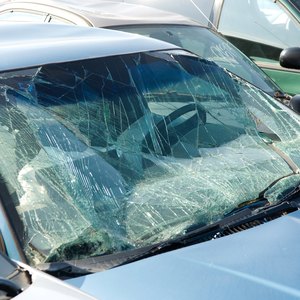
A rock hit your windshield, a crook broke your window -- whatever the case, you have a broken car window. Now you're wondering: "Do I fix it myself or call my insurance agency?" One thing you may be worried about is that it will count against your policy, meaning higher rates in the future. Fortunately, auto glass damage usually doesn't count against your policy.
When You're Covered
Before you have any repairs done, contact your insurance agency, which may have policies on how your glass can be fixed. You don't want to end up having to pay out of pocket if you don't have to pay. Typically, you must have comprehensive or glass coverage for your broken car windows or windshields to be covered by insurance. This may come with a deductible. If the cost of the repair is less than your deductible, it might not make sense to fill out a claim.
When Glass Breaks
Filling out a claim for glass replacement or repair in a noncollision case typically will not count against you. In fact, many insurance agencies allow you to fill out a "glass-only claim." Check with your agent or insurance company to find out what its specific policy is.
References
- Progressive: Windshield and Glass Claims
- DMV.org: How To Cover Windshield Repair Through Car Insurance
- Allstar Quality Auto Glass Service: Windshield Repair FAQ
- Allstate: Auto Glass Claim Express
- CarsDirect: Windshield Repair -- Will My Insurance Cover It?
- Auto Glass Stop: Insurance Claims
- Insurance Journal. "Helping Policyholders Understand Auto Glass Repair Or Replacement Options." Accessed April 7, 2020.
- National Association of Insurance Commissioners. "A Consumer's Guide to Auto Insurance," Page 2. Accessed April 7, 2020.
- Erie Insurance. "How to Handle a Windshield Repair." Accessed April 7, 2020.
- GEICO. "Your Guide To Glass And Windshield Insurance Claims." Accessed April 7, 2020.
- State Farm. "Windshield Repair and Glass Claims." Accessed April 7, 2020.
- AAA. "Windshield Repair And Replacement." Accessed April 7, 2020.
- Allstate. "Does Car Insurance Cover Windshield Damage?" Accessed April 7, 2020.
- GEICO. "How Will a Claim Affect My Policy & Insurance Rates?" Accessed April 7, 2020.
- The Florida Senate. "Section 610: Safety of Vehicle; Inspection." Accessed April 7, 2020.
- GEICO. "How To Get A Cracked Or Chipped Windshield Repaired." Accessed April 7, 2020.
- Safelite Auto Glass. "Safelite FAQs." Accessed April 7, 2020.
Writer Bio
Specializing in food and business, Melissa Haskin is a Oregon writer who received a Bachelor of Science in economics with an emphasis in business from Oregon State University. She completed graduate work in journalism at the University of Oregon and has contributed to publications such as "The Register-Guard," "Oregon Quarterly" and "Eugene Magazine."

